Brushed Gold Shower Systems vs Shiny Gold Shower Systems
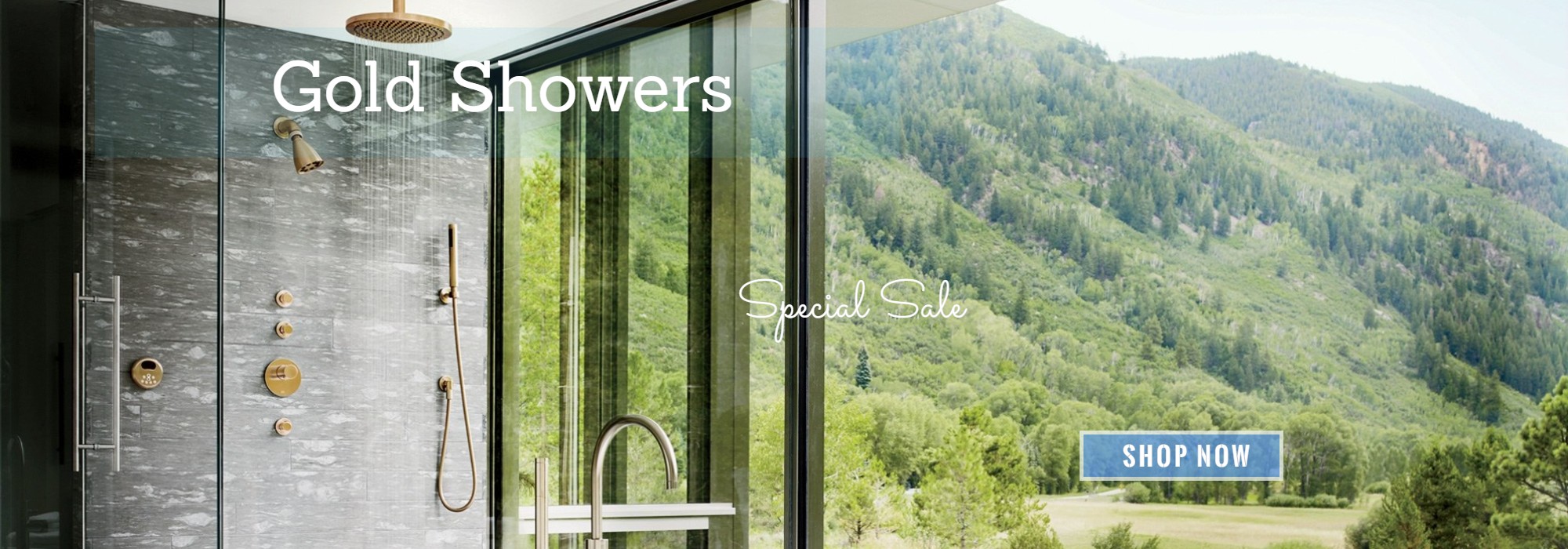
Curious about the difference between brushed gold and shiny gold?
When choosing a perfect shower system for your bathroom, the finish is the most crucial factor that dictates the area’s overall look. Gold finishes especially brushed gold and shiny gold, are currently making a widespread comeback. What are the fundamental differences between the two? Quality differences, design, price, compatibility with other fixtures, and suitability for both modern and traditional bathroom styles.
💡 Did You Know?
Brushed is a soft, matte elegance ideal for low-maintenance luxury, while a shiny/brilliant/polished gold finish delivers high-gloss opulence!

Prefer a gold finish that’s elegant but low-maintenance? Want a gold finish that hides fingerprints and scratches easily?

Is the brushed gold easier to maintain and keep clean?

Generally speaking brushed gold is easier to maintain and keep clean compared to polished finish, howver lower-quality finishes not PVD (Physical Vapor Deposition) coated for protection may be more prone to wear, discoloration, or uneven patina. The brushed gold can be an excellent low-maintenance option for those who want a sophisticated, modern look without the constant upkeep.
💡 Did You Know?
The brushed matte finish hides fingerprints, water spots, and scratches and requires less maintenance than shiny/French gold surfaces.
Brushed gold is such a matte finish. While it will not be as eye-catching or striking as brilliant gold, it is also not as apt to show fingerprints or water spots and stains; hence, brushed gold can hide scratches and minor imperfections better than brilliant gold can while maintaining the warmth and luxury without constant upkeep.
Are you looking to add bold warmth and richness to your bathroom? Brilliant gold can enhance the overall design and style of the bbathroom.

Why choose brilliant gold fixtures? While being shiny and reflective does require more maintenance to stay clean or free from water spots and fingerprints, it absolutely creates a bold and luxurious statement in this bathroom space. No doubt, brilliant gold will always suit a wider color and finish palette in the space, allowing any bathroom design to execute such a finish cohesively.

Why consider brushed over brilliant gold? Overall, polished or French brilliant gold always reveals stains, scratches, and imperfections far more than brushed gold can, which continues to be a concern for people who want a finish that should last for years without revealing any wear and tear.
💡 What is the best system in gold finish?
Discover the Catanzaro Shower System, which features remote-controlled LED lighting, rainfall, waterfall, mist modes, and 6 body jets—combining luxury and precision!
Starting At: $3,934.84
Starting At: $3,632.84
✨ Discover the unique Parma Remote Brushed LED Shower System ✨
✨ Discover the unique Bravat Showers ✨
✨ Explore the elegance of the Brushed Finish Shower System ✨
✨Discover the innovation of Digital Brushed Gold Shower Systems ✨
Ultimately, the decision between those finishes comes down to two main factors your personal preference and the overall style and design of the bathroom space.
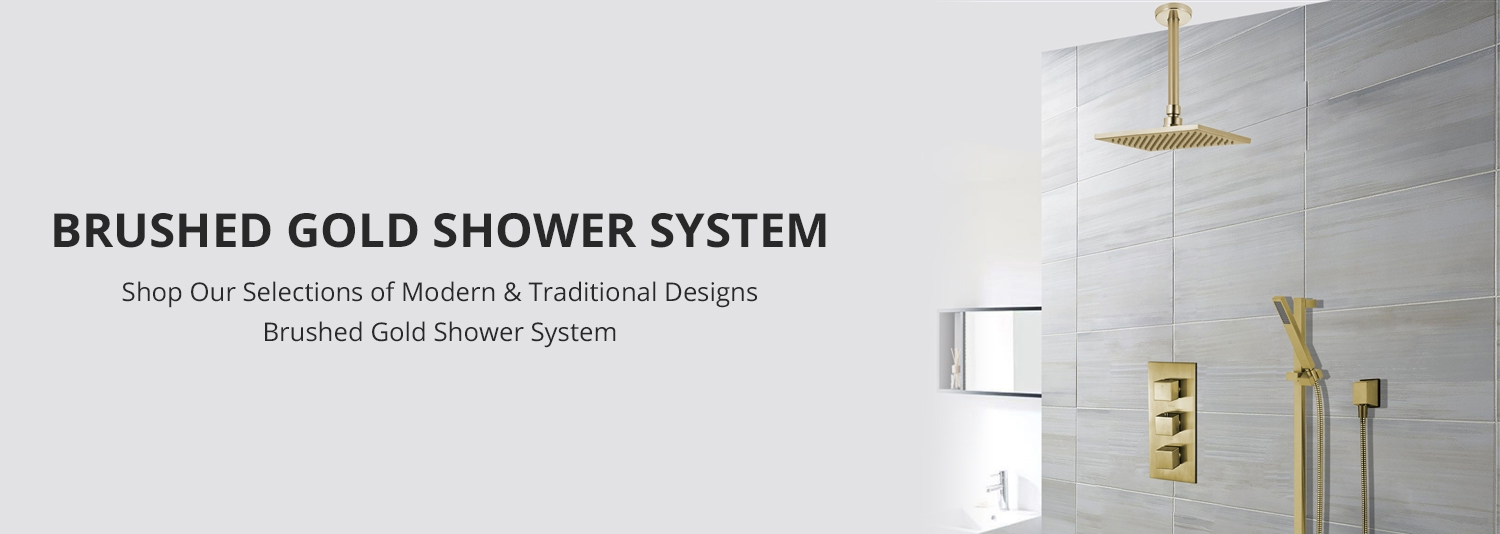
Brushed Gold vs. Brushed Brass
Brushed Gold and Brushed Brass Offer Distinct Visual Characteristics

While both brushed gold and brushed brass radiate a warm, sophisticated appearance, their composition, and hence, characteristics vary.
It’s usually made out of brass base metal alloy, with a thin layer of gilded gold over it. The thickness can vary by karatage to the gold content, but 24-karat gold is the most pure and highly valued. Colors are mostly rich and luxurious, to mostly add class to any space, and usually come in warm tones with great yellow color. They can also be further modified using different treatments applied on the surface; examples include matte or satin finishes
Why choose brushed brass over gold? On the contrary, brushed brass is primarily brass—an alloy of copper and zinc. Unlike brushed gold, which has a gold coat, the color in brushed brass is really the color of brass. This shows much more of a dulled golden color with earthy undertones, therefore really fitting for those who want a more low-key yet stylish finish. It could be finished with different textures, similar to brushed gold. Although both brushed gold and brushed brass offer warm, sophisticated look, but their composition and characteristics differ.

Brushed gold is typically made of brass base metal alloy coated with a thin layer of gold. The gold layer can vary in karatage, with 24-karat gold being the purest and most valuable. Brushed gold exhibits a rich, luxurious appearance that adds elegance to any space. It often features a warm, yellow tone and can be further customized through different surface treatments, such as matte or satin finishes.
- Chrome vs. Brushed Nickel Bathroom Fixtures: What is the Difference?
👉 Read more here - Oil Rubbed Bronze vs. Matte Black Showers
👉 Learn more here - Brushed Gold Shower Systems vs. Shiny Gold Shower Systems
👉 Explore the article here - Brushed Nickel vs. Polished Nickel.
👉 Read more here - Brushed Nickel Showers vs. Stainless Steel Showers
👉 Learn more here - Satin Nickel or Brushed Nickel Bathroom Fixtures?
👉 Explore here
Brushed Gold Rain Shower HeadStarting At: $425.33

On the other hand, the brushed brass is predominantly composed of brass, an alloy made by combining copper and zinc. Unlike brushed gold, which features a gold coating, brushed brass showcases the inherent color of brass itself. It displays a slightly muted golden hue with earthy undertones, making it an excellent choice for those seeking a more subtle yet stylish finish. Similar to brushed gold, brushed brass can be finished with different textures to achieve desired effects.

Now, on the durability and maintenance for those finishes in long-lasting applications, the brushed gold is highly durable and resistant to tarnish. However, the gold layer can be delicate and thus will require more careful maintenance and cleaning in order to preserve the shine over some time. The brushed brass, mainly made from brass, is also durable and less prone to tarnishing.
Brushed Brass vs Brushed Gold

Brushed brass and brushed gold are two different finishes applied to any interior design or plumbing fixture. While both will have a warm, yellowish tone and give classical, timeless looks, brushed brass will be warmer in shade, whereas brushed gold is deeper golden and exudes an air of luxury and ultra-modern elegance. They both come with a brushed texture, making them a little matte in appearance, and seem to go with a host of designs.

Ultimately, the choice between these two lies in personal preference and what look a space owner is going for. Brushed brass is both timeless and versatile with its classic look, so it can fit into many design styles. It’s very resistant and relatively easy to clean, but it does have the tendency to tarnish as time passes. On the other hand, Brushed Gold speaks of a lot about luxury and modern sophistication when adapted to a very bold statement piece that would really blend perfectly with contemporaries.

Although it manifests at a higher price, the brushed gold contains high durability and anti-corrosion qualities. On the downside, though, this distinguished look can fit nowhere, and it involves further sensitive cleaning methods. Ultimately, the choice between brushed brass and brushed gold rests on compatibility with the desired style and what one is willing to trade off.
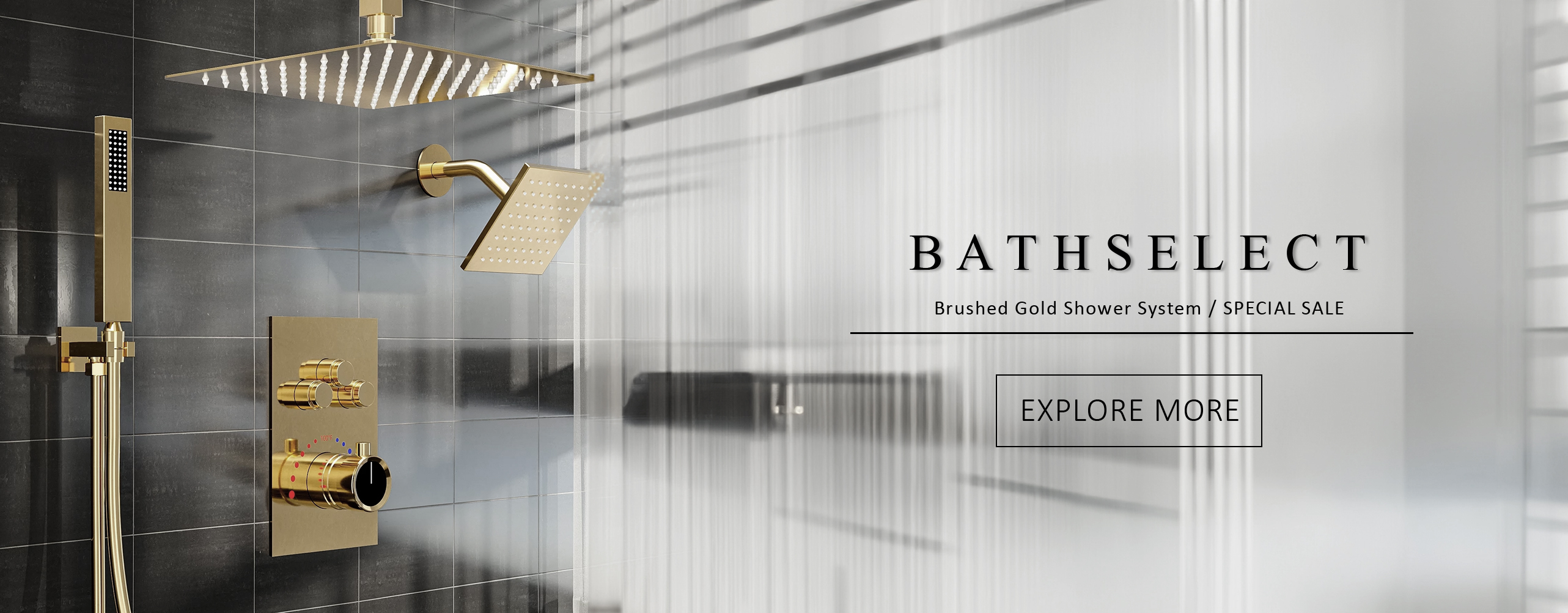
What is a Gold Shower
Gold shower refers to a type of shower system or fixture that features a gold finish, which includes various components such as the showerhead, faucet, handle, and trim, all finished in a gold coat or plating. It, therefore, gives the shower a rather luxurious finish that creates a visually striking and upscale look. This makes the gold showers sought after in enhancing the general upper-scale visual appeal of a bathroom with a touch of opulence and sophistication
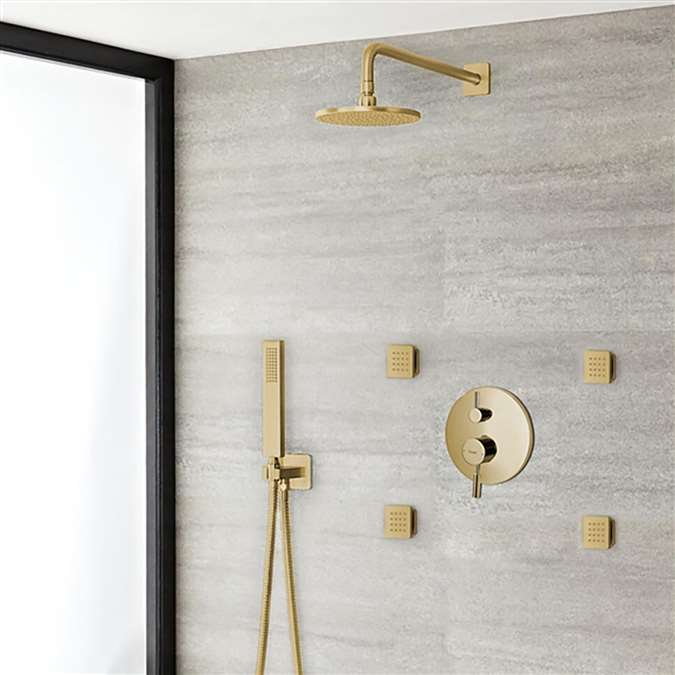
BathSelect prides itself on offering large collections of showers finished in gold to give customers a fair share of choices. When searching for something more than just an ordinary shower, our collection offers great styles and features for improving your bathing experience.
The Massage Gold Showers offer an indulgent experience in a mix of functionality, allowing soothing massage jets to fall from the showerhead. You can choose from different settings and pressure levels in massage intensity to suit your preference.
The showers evoke peace, replicating the feeling of standing under a light rain shower or even a cascading waterfall. They provide soothing and immersive bathing experiences with their wide showerheads and well-placed nozzles
These LED gold showers give some taste of modernity and a lot of visual appeal in any bathroom. Such devices are defined by embedded LED lights in the showerhead or along the jet of water flashing in different colors, creating an amazing view when the showering person is shimmering

Bluetooth gold showers bring technology mixed with a taste of luxury into your shower, offering you the opportunity to have your favorite tracks or podcasts right inside the shower cubicle. These showers are fitted with sophisticated Bluetooth connectivity, which enables one to pair a mobile device and wirelessly stream audio for quite an immersive and indulging shower.
Spa gold showers are fully packed with numerous features that are sure to bring indulgence from the professional spa right into your bathroom. Two showerheads, body jets, steam options, aromatherapy choices, and many other additions can make for a very lavish and rejuvenating experience in the comfort of your home.
With such a divergent array of gold showers, BathSelect looks to fulfill a variety of different tastes while providing the upgrade to their customers’ showering experience through the combination of style, functionality, and luxury.
What are the Challenges of Fixing Scratches on a Brushed gold shower system?
Scratch repair in a brushed gold shower system is uniquely challenging and requires nuanced approaches to ensure the integrity of the finish while effectively repairing the damage. Brushed gold finishes are preferred by many for their elegant and warm-toned, sophisticated look. Being delicate, however, they easily show wear and tear. Here are the major challenges associated with fixing scratches on a brushed gold shower system:
How can scratches on brushed gold finishes be minimized without altering their unique texture?
Protecting Perfection: Brushed Gold Repair Made Easy.
Maintaining the appeal of the Finish
The greatest odd against getting the Burns’ scratched brushed gold finishes repaired is maintaining the attractiveness of the surface. The brushed gold does have a particular texture and slight sheen on it, both of which may be easily marred by some methods of repair. What needs to be done is to eliminate or reduce the scratches without affecting its special brushed pattern. This will call for great care and the use of the right materials that will easily blend with the underlying finish. The brushing effect, which includes fine lines that run in one direction uniformly, may be tricky to imitate in case of damage.
Material Selection
What role do special metal polishes play in maintaining brushed gold finishes?
Shine Safely: Trusted Polishes for Brushed Gold Care.
Choosing the right cleaning and scratch repair materials is very critical. A brushed gold finish can be very easy to scratch with abrasive material or harsh chemicals, which will further deteriorate the damage. Fine-grit sandpaper, special metal polishes for gold finishes, and soft microfiber cloths are recommended as the materials of choice. Still, striking a balance between scratch removal and protection of the finish is challenging, as overly aggressive products may remove the gold plating or alter its texture.
Match to Gold Tone
A very good example of another significant challenge would be matching the exact shade for gold; brushed gold finishes may be a bit different in tone depending on the manufacturer and specific alloy used. This variation means that any touch-up work must be done with an eye for color matching, if the repaired area needs to blend into the remaining shower system. Doing this does not come easily, especially if the scratch is deep and more extensive repair is needed.
Avoiding Further Damage
In the repair work, chances of further damage to this gold-finish brush are always there; it should be sanded and polished very carefully to avoid scratching or dulling the finish. Being a delicate finish, even a little carelessness may bring in further imperfections, thereby making the job of repair more complex and hence, more noticeable.
Long-Term Maintenance
Even with successful scratch repair, it can be quite a challenge to maintain the integrity of a brushed gold shower system in the long term. Gold finishes will tarnish and require regular maintenance to stay pristine. This includes gentle cleaning products and methods that won’t cause new scratches to form and allow the gold finish to look vibrant without oxidation or discoloration.

The process of repairing scratched brushed gold shower systems poses many challenges: finish aesthetics to be maintained, correct repair material application, gold tone matching, causing no further damage, and also having a long-term maintenance strategy in place. From planning through execution, each step needs care if a seamless repair is to keep the luxurious appearance of this brushed gold finish. Good care and maintenance will help in retaining the elegant look of the shower system and avoid further scratches that might destroy its beauty. Questions and Answers
What are the main challenges in fixing scratches on a brushed gold shower system?
Major concerns will therefore be the retention of the aesthetic appearance of a brushed gold finish, material selection for the purpose of repair, matching shade of gold color, avoiding further damage in the course of repair, and really long-term maintenance against new scratches and tarnishing.
How to preserve brushed gold finish when fixing scratches?

To preserve the brushed gold finish, only fine-grit sandpaper should be used—600 grit and finer—together with specialized metal polishes for gold finishes. Gently rub it in the direction of the brushed lines, making sure to use very soft microfiber cloths so that no added scratches will appear. The key is to blend the repair seamlessly with the existing finish.
What materials shall I use to repair scratched brushed gold shower systems?
Fine grit sandpaper—600 grit or finer—Scotch-Brite pads specifically designed metal polishes for a gold finish, soft microfiber cloths. Never use harsh chemicals or abrasive materials. These are very likely to either remove the gold plating or change the finish texture.
How do I match the gold tone when repairing scratches?
The gold tone can be matched but only within a slight variation in color. Touch-up products from finish shops are specially made to work for gold finishes; test first in an inconspicuous area. Perhaps a few different products will have to be used to attain the best possible join. Blend slowly and carefully to attain a seamless repair.
How best can I avoid further damage while making the repair for scratches?

Gold Shower Heads
Work slowly to ensure gentle pressure when sanding or polishing in only one direction of the brushed finish, not circular. Constantly inspect your work for oversanding and overdrive pressure.
How to maintain a brushed gold finish to prevent future scratches?
This will mean that a well-maintained shower system often lasts much longer. Clean the showers frequently with mild cleaners and soft rags. Wear off harsh chemicals, abrasive scrubbers, and any scratching object may harm the surface. Now add extra care by protective waxing or applying some sealant to a newly installed faucet.
Are there any possible ways to repair deep scratches in a brushed gold finish professionally?
Deeper scratches are more difficult to completely repair but most can be significantly reduced. Fine grit sandpaper and careful polishing can make them almost invisible. If the scratch is really deep, though, restoration or part replacement by a professional might be in order.
Are there any products that you would suggest for repairing scratches to brushed gold finishes?
A8: While specific product recommendations may vary, fine-grit sandpaper—600 grit or higher, metal polishes designed for gold finishes, high-quality microfiber cloths—and touch-up kits provided by some brands for gold finishes can go a long way toward the success of a seamless repair.
What is the frequency of maintenance needed with my brushed gold shower system?
Brushed gold finishes require at least monthly maintenance to stay in good condition. This includes mild, non-abrasive cleaners, drying a surface to prevent water spotting, and applying protective wax or sealant as needed.
Can any professional help be hired to fix a scratch on a brushed gold shower system?
Yes, a professional service specialized in metal restorations can help you repair scratching on a brushed gold shower system. They have a professional eye and the right equipment to remove deep scratching and thus restore the finish to its original form. This is especially useful when extensive damage cannot easily be fixed at home.
Related Links

Brushed Gold Faucets On Sale
Browse our unique selection of brushed gold faucets that are on sale. Providing a sleek look, these high-end faucets offer everything from style to class in any bathroom or kitchen setting. Brushed gold kitchen faucet

Brushed Gold Single Hole Bathroom Faucets
Find beautiful-looking brushed gold single hole faucets for that added touch of sophistication and style in your bathroom. These faucets are designed to conveniently install and mesh well with modern or traditional designs.

Brushed Gold Tub Faucets
Add elegance and warmth to your tub with brushed gold tub faucets. Whether your bathroom is ultra-modern or traditionally styled, these faucets marry visual appeal with durable function.

Brushed Gold Sink Faucets
Give your bathroom an uplift with our brushed gold sink faucets. Classic finish works with numerous color schemes, bringing style and a touch of luxury to any sink space.

Brushed Gold Bathroom Faucets
Upgrade your bathroom style with our brushed gold bathroom faucets. Ideal for providing a neat look, these brushed faucets will be perfect for modern and vintage themes.

Brushed Gold Shower Faucets
Give a luxurious treat to your shower with our brushed gold shower faucets. These will add beautiful contrast to the neutral or bold bathroom design and lift the aesthetic appeal.
.jpg)
Brushed Gold LED Faucets
Enjoy the feel of the brushed gold LED faucets that combine modern technology with timeless elegance. They form a special visual experience, ideal for bathrooms of high class.
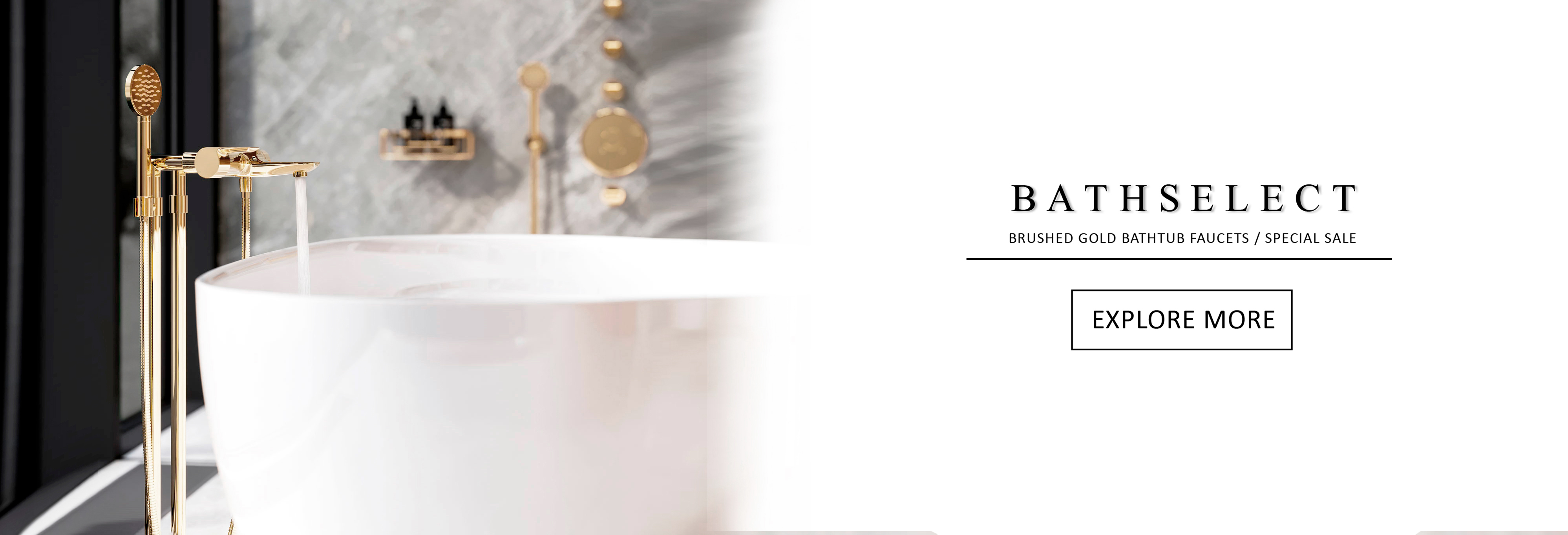
Brushed Gold BathTub Faucets
Give your bathtub an exquisite finish with rich sophistication using brushed gold faucets. Such types of faucets are perfect in creating a spa-like ambiance while being durable and stylishly functional.

Brushed Gold Waterfall Bathtub Faucets
Relax in a waterfall bathtub faucet’s trickle in brushed gold; their elegant design enhances every luxury bathroom, giving it a very modern feel with gentle, cascading water.

Brushed Gold Waterfall Sink Faucets
Add serenity to your sink with brushed gold waterfall faucets. These unusual fixtures offer soft, calming water flow and a finish that would enhance any bathroom decor.
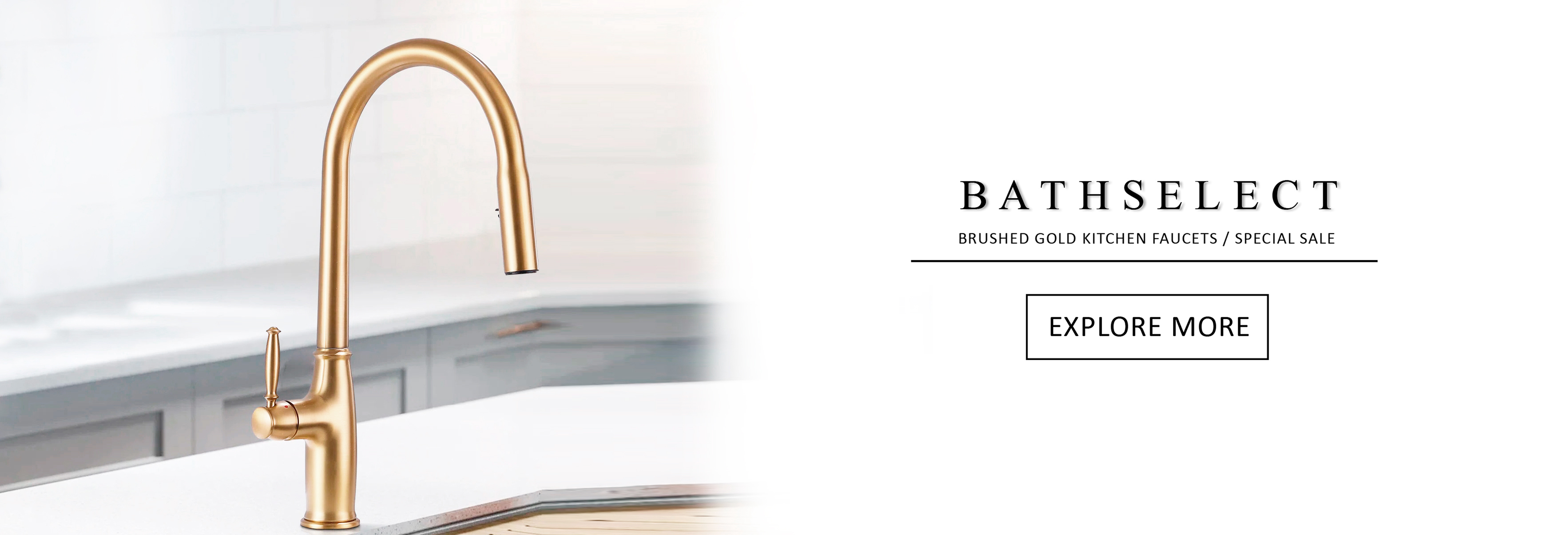
Brushed Gold Kitchen Faucets
Introduce classic fashion with trendy warmth into your kitchen area with its brushed gold faucets. Whether modern or classic, these faucets truly bring a touch of modern luxury and functionality.
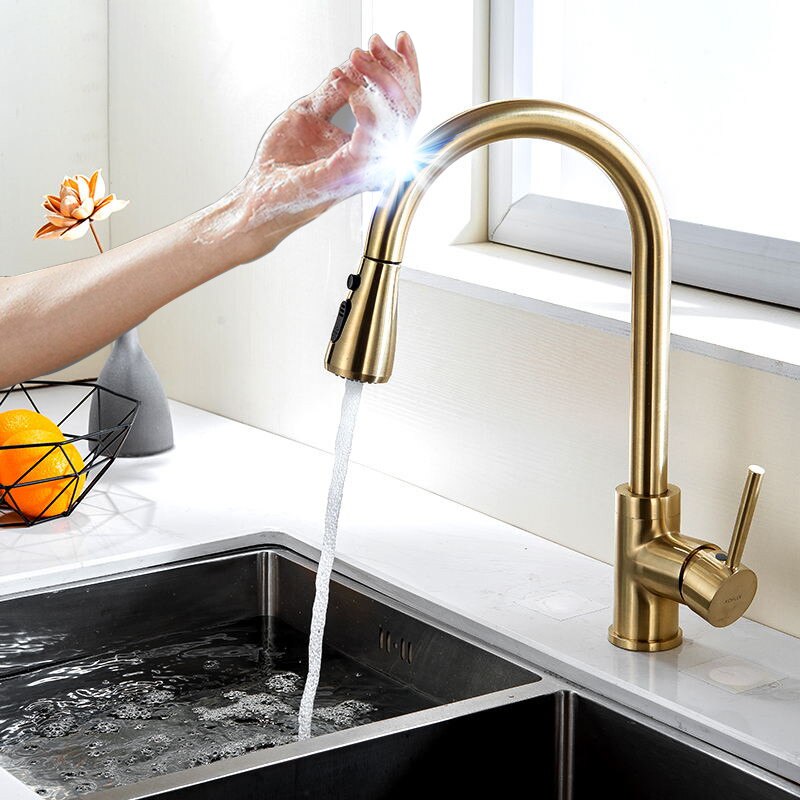
Brushed Gold Kitchen Touch Faucets
Experience the simplicity of style, together with ease-of-use, that brushed gold kitchen touch faucets bring to kitchens. By simple touch-on/Turn-on activation, these faucets can easily blend innovation with style for the busiest kitchens.
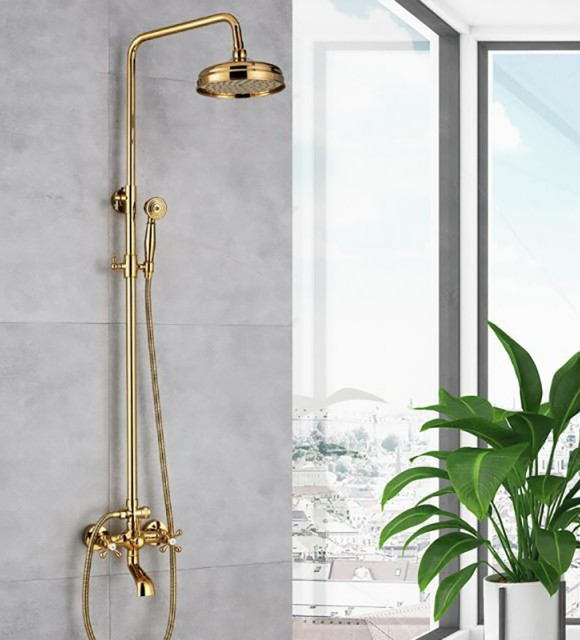
Brushed Gold Showers On Sale
Find the finest quality brushed gold showers at cost-effective prices. These shower accessories add a glow of luxury, richness, and more to various styles in your bathroom.

Brushed Gold Showerhead
Add a touch of style and functionality to your shower with these brushed gold showerheads. Their timeless design makes them blend smoothly into any bathroom theme for that refined look.

Brushed Gold Shower Faucet
Add a touch of luxury to your shower with the finest quality brushed gold shower faucets. It is fitting to create a coordinating bathroom look in a warm, stylish finish.

Brushed Gold Shower System
Learn how the brushed gold shower system provides a coordinated look to your bathroom; from comprehensive sets to a spa-like experience. These are accented by a stylish finish that can raise any space up a notch.

Brushed Gold Shower Arm
Complete your brushed gold shower set with matching shower arms. These arms ensure that the design is complete, adding elegance to the shower area with durability and style.
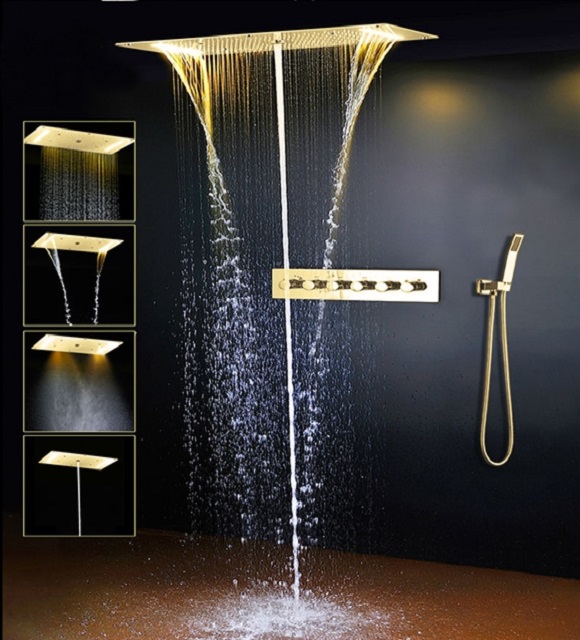
Brushed Gold LED Shower System
Experience a complete shower with the brushed gold LED shower system. Employing technology from lighting with a beautifully rendered finish, these shower systems bring an ambiance of luxury into the bathroom.

Brushed Gold LED Showers On Sale
This is where you get brushed gold LED showers on sale. An exceptional feature in terms of lighting, these would be ideal for a shower setup, contemporary and luxurious.

Brushed Gold Rain Shower System
Have a refreshing shower in the rain with brushed gold rain shower systems. These appliances boast gentle water flow and elegant looks, ideally suited for spa-inspired bathrooms.

Rain Shower and Body Sprays Brushed Gold
Replace your shower with our brushed gold rain and body spray systems for complete coverage, added style, and an ultimate relaxing experience.

Brushed Gold Shower Systems with Body Jets
Experience the ultimate in relaxation with our brushed gold shower systems featuring body jets. With their focused water massage, these systems add spa comfort and style to the bathing area.

Multi Jet Shower System Brushed Gold
Enjoy a brushed gold multi-jet shower system for full-body coverage. These systems are both therapeutic and have a luxurious finish to complement any style of bathroom.

Brushed Gold Color Changing Shower System
Give your bathroom a new feel with brushed gold color-changing shower systems. These change colors with water temperature for an added flair in the shower.

Bathtub & Shower Systems Brushed Gold
Combine bathtub and shower luxury with brushed gold systems. Such an integrated system will be versatile and elegant; thus, it is ideal for creating a seamless stylish bath space.

Rain Shower System with handheld Brushed Gold
Experience flexibility and elegance with the rain shower system in brushed gold, featuring a handheld option. This system effortlessly serves up relaxation and functionality with an amazing finish.
.jpg)
Brushed Gold Showerhead On Sale
Browse sale brushed gold showerheads for a fashionably atas choice. These showerheads raise the style of your bathroom and would work in a variety of theme styles.

Waterfall Showerhead Brushed Gold
Get soothing rain from a waterfall showerhead finished in brushed gold. This piece of equipment takes your shower to a completely new level. Every day, feel like you are at a spa with this unique piece sporting a warm, sophisticated look.

Rain Showerhead Brushed Gold
Enjoy the soothing rain with brushed gold rain showerheads. Accessories that make a tranquil experience, complementing any modern or classic bathroom with a very stylish, elegant finish.

LED Showerhead Brushed Gold
Give your shower a romantic ambiance with LED brushed gold showerheads. Combining luxurious finishes with light effects in a showerhead enhances mood and aesthetics in your bathroom.

Color Changing Showerhead Brushed Gold
The most unique shower experience would feature color-changing brushed gold showerheads. These change colors with temperature and add additional style, along with practical uses, to any shower.
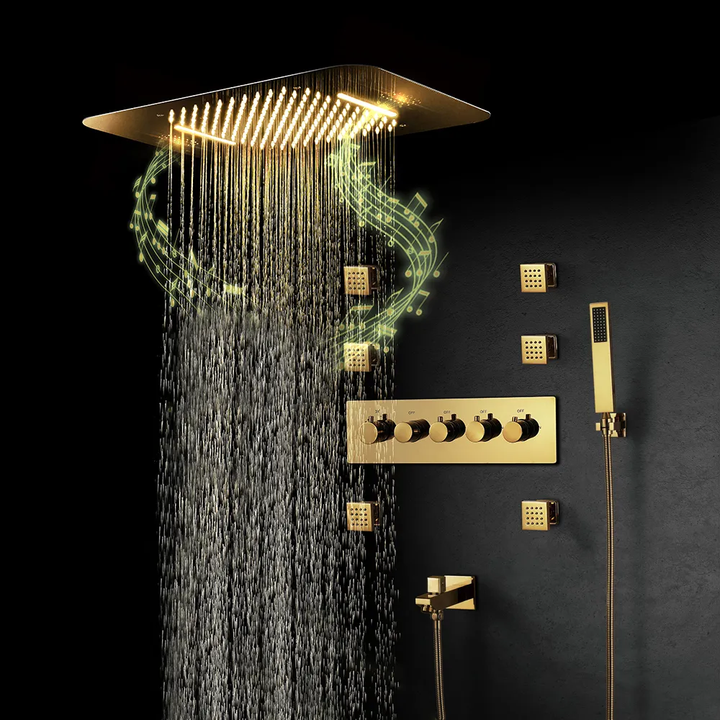
Multifunctional Showerhead Brushed Gold
Get multi-function brushed gold showerheads for a showerhead that can boast a number of spray settings. Truly stylish yet highly versatile, these showerheads are ideal for every individual who would like his or her style in a shower.

Showerhead with Handheld Brushed Gold
Enjoy added flexibility with a brushed gold showerhead that includes a handheld option. This dual-purpose fixture brings both elegance and convenience to modern bathrooms.

Brushed Gold Showerhead Extension
Add some extra reach to your shower with brushed gold showerhead extensions. These extensions go really well with brushed gold and give a consistent appearance of luxury.

Brushed Gold Showerhead Set
Complement your shower fixture with a brushed gold shower head set. These matched sets lend an air of opulence, ideal for a luxury, coordinated bathroom format.

LARGE Showerhead Brushed Gold
Add style and class to your shower with its wide-coverage large brushed gold showerhead. The comfort in luxury of this fixture makes it an eye-catcher centerpiece in any shower area.

Best Showerhead Brushed Gold
The best-brush gold showerheads that speak to style and functionality. High-quality fixtures are featured, with an upscale finish to make for a stylishly luxurious shower that complements your style.
Chrome vs. Brushed Nickel Bathroom Fixtures: What Is the Difference? Chrome and brushed nickel are two most widely used bathroom fixture finishes, each differently advantageous. Chrome fixtures, normally having a thin layer of electroplating with chromium, possess a very reflective, mirror-like surface that looks great with modern and minimalist settings. The finish doesn’t tarnish much, and it has a sleek, clean look; however, there can be issues with water spots and fingerprints, so it tends to need quite a bit of ongoing maintenance. Brushed nickel features subtle, matte finish with fine texture provided by wire brushing or abrasives. This finish presents a warm, mellow tone, which works well with traditional or transitional styles. Brushed nickel is more forgiving in terms of fingerprints and water spots, requiring less cleaning than polished. On the other hand, because of its textural finish, it tends to let dirt and grime fill its crevices over time, also due to the more intricately tactile nature of the metal. Technically speaking, both finishes are durable, though the manufacturing process for brushed nickel is more labor-intensive, making this finish a little pricier. This is often a question of aesthetic preference and maintenance requirements.
Flow of Water from a Shower Head The question of the flow of water from a shower head is determined by a number of technical factors flowing rate, water pressure, and the engineering of the shower head itself. Federal law in the U.S. has imposed a restriction of 2.5 GPM at 80 psi to conserve water, although newer models may have lower flow rates and have no effect on performance. In fact, the way the internal nozzle structure is designed in a shower head enables the volume and direction of water flow to be controlled properly. Some shower heads now have air-injection technology that mixes air with water to enhance the pressure without consumption, hence yielding a more forceful shower experience even at lower flow rates. Distribution and intensity also continue to vary with spray patterns, which can be adjusted by design: rain, massage, and jet modes for an increasingly personalized experience. Apart from this, the flow restrictors that are installed to meet the requirements set for environmental safety also contribute to water consumption reduction. The right choice of shower head for your plumbing system can guarantee optimal performance since low water pressure significantly lessens the efficiency and comfort of the shower.
Brushed Nickel Shower vs. Stainless Steel Showers Brushed nickel and stainless steel showers have been two extremely durable finishes in the shower systems, but they have different properties. Brushed nickel is a softer, warmer finish that is achieved by brushing the surface of the metal to create a subtle texture. Its matte look makes it very good at hiding fingerprints and water spots, thus perfect for high-traffic showers where maintenance might be a challenge. On the other hand, stainless steel is generally finished to a smooth polish and is noted for its resistance to corrosion and strength, particularly in areas with much moisture, such as showers. In fact, stainless steel has a much cooler industrial look that works well in modern bathrooms. Technically speaking, stainless steel showers are at an advantage over rust and tarnish because the presence of chromium forms an invisible layer of oxide on the surface that acts to inhibit corrosion. While brushed nickel holds up most against wear and tear regarding concealment of minor scratches and fingerprints, stainless steel tends to outlast it in pure durability and resisting agents facilitating tough cleaning or high humidity. In the final analysis, options will often depend upon aesthetic preference and on the level of maintenance the user is willing to commit to.
Brushed Nickel vs. Polished Nickel Both brushed nickel and polished nickel finishes have their own unique aesthetic appeals and functional benefits; however, they are rather different in appearance and maintenance. The finish of the brushed nickel is soft and textured, made by brushing the surface with abrasives giving a soft, muted satin look. The finish does a more excellent job of hiding fingerprints, water spots, and minor scratches. Therefore, it is suitable for busy homes or commercial settings that have constant use of fixtures. The polished nickel boasts of a smooth, highly reflective finish that resembles chrome but in a warmer tone. Nickel polished gets its lustrous finish by polishing and electroplating processes; this gives a bright and mirror-like finish. On the downside, this reflective surface tends to show more smudges, water spots, and tarnishing, hence requiring frequent cleaning to maintain the shine. Technically speaking, both finishes are quite durable and resistant to corrosion, but brushed nickel is more lenient on maintenance. In contrast, polished nickel boasts a lovely arresting look that is more practical for areas with lower traffic or the end-user who likes it a bit more luxurious and high maintenance.
Brushed Gold Shower Systems vs. Shiny Gold Shower Systems Brushed gold and shiny gold shower systems present two different aesthetic options, each with different technical specifications. The brushed gold features a discreet, matte finish that is achieved by brushing on the surface with the intent of reducing its reflective quality. Warm and radiating in subtle elegance, it is suitable for both classic and modern bathroom designs. The textural finish will also have the added benefit of hiding fingerprints, water spots, and minor scratches quite easily and prove to be more appropriate in high-use situations that require low maintenance. In contrast, shiny gold is a more opulent, reflecting surface-one speaking of luxury and glamour. This bright, highly polished finish is achieved by polishing and then electroplating. It is brilliant but tends to show smudges and water spots, so needs regular cleaning to maintain brilliance. Technically, the two finishes are robust, being applied over substrates of either brass or stainless steel for added corrosion resistance. However, brushed gold tends to be more practical for everyday use, while shiny gold is ideal for anyone looking to make a statement in their bathroom. This choice between the two finishes often has to do with finding a balance between aesthetics and ease of maintenance.
Oil Rubbed Bronze versus Antique Bronze Oil rubbed bronze and antique bronze are two finishes that are in high demand, adding a touch of richness and classic style to bathroom fixtures; however, they vary in looks and manufacturing processes. Oil rubbed bronze is usually attained through chemical processes which darken the surface of the metal to a deep, almost black finish with subtle copper undertones. The finish is sleek, smooth, and often applied in traditional or rustic bathroom settings. On the other hand, antique bronze is artificially aged on the surface layer to give it that worn, aged look of time. It has a lighter look that is more textured and often bears streaks or patina that enhance its appeal for vintage purposes. On a technical note, oil rubbed bronze is color and texture consistent, whereas antique bronze varies based on the depth of the finish and the aging process used. For special care, as with either finish, tarnishing must be prevented, and to preserve their respective looks, harsh cleaning agents strip away the patina or darkened surface. Although both finishes boast a feeling of durability and timelessness, oil rubbed bronze is used to offer a more modern feel to an otherwise classic style, while antique bronze uses mostly traditional and old-world aesthetics.
















